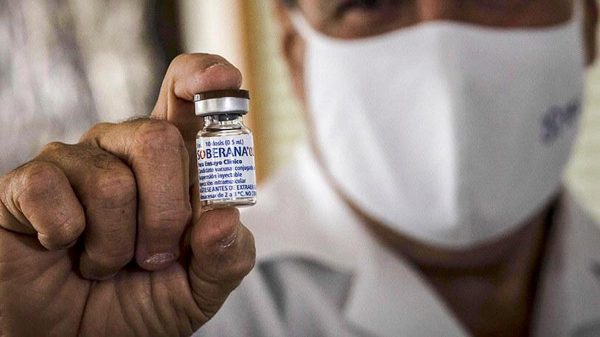Dr. Vicente Vérez Bencomo, Director of the Finlay Institute of Vaccines announced August 19 that Cuba now has its candidate, SOBERANA 01, the vaccine against COVID-19. This announcement came on the 105th anniversary of the death of the discoverer of the agent that transmits yellow fever, Dr. Carlos J. Finlay, whose name this institution bears.
After three months of hard work that started in May and after a meeting held by Cuban President Miguel Díaz-Canel with scientists, the Cuban vaccine candidate was registered at the Center for the Control of Quality of Medicines (CEDMED), the regulatory authority in Cuba.
Identified with the acronym FINLAY-FR-1, it will begin the clinical trial phase on August 24 with two age groups, from 19 to 59 and from 60 to 80 years old. Phase II will begin on September 11 and will include another 676 volunteers.
But how could Cuba, a country under unimaginable coercive measures, without any international financing, without access to many technologies, and key materials for its development, reach this result that is the first among undeveloped countries and the 30th candidate in the world?
To this end, Cuba has established a strategy composed of three elements:
- First, the element of time. It was not possible to wait 10 years to obtain a result in this sense. All the processes had to be accelerated and it helped a lot to have a platform of previous experiences in the production of other vaccines in the institutions.
- Second, the complementarity of scientific, technological and productive capacities. The Finlay Institute, on its own, would not have been able to complete the task. That is why an alliance was formed with the other centers that could solve multiple tasks in this endeavor. The Finlay Institute put into practice the idea and the conception of the vaccine candidate; the Faculty of Chemistry of the University of Havana complemented basic research capacities at a more molecular level and in the characterization of molecules; the molecular biology laboratory of the Civil Defense Research Center provided capacities for the evaluation of immunological variables and the Center for Genetic Engineering and Biotechnology worked on the structural characterization of the chosen antigen.
- Thirdly, that of the platforms. The technological platforms that the Finlay Institute and the Center for Molecular Immunology already had were combined.
For the clinical phase, the National Center of Toxicology and the Pedro Kouri Institute of Tropical Medicine will be used as clinical sites.
In information disseminated by the media, Dr. C. Dagmar García Rivera, Director of Research at the Finlay Institute and one of the people responsible for the project, highlighted that as a result of the study carried out and the scientific information gathered on May 22 for the first time the antigen to be used in the vaccine candidate project was defined, the RBD protein which was the most important in the virus for its entry into the human cell.
Cuba has the scientific and technological capacity to produce the millions of doses needed by the island’s inhabitants and even to export them.
It should be noted that on July 28, the tests with humans began with the vaccination of SOBERANA 01 vaccine on three doctors Vicente Vérez, director of the Finlay Institute, Yuri Valdez and Dagmar García, also directors at Finlay.
At the meeting between the Cuban president and the scientists, the results of the tests with Nasalferon and the CIGB-325 were also presented.
These results demonstrate the integrative and complementary capacity of the Cuban scientific system that can develop multiple projects against different health problems and combine all the essential elements that make up a closed cycle of research, development, production, marketing and post-sale follow-up, as well as a reliable control and registration system.
The Cuban Government’s political willingness to provide poor countries with a vaccine that will enable them to combat COVID-19 more effectively is well known.
But, not only to poor countries. The Cuban government has made it known that it is willing to cooperate even with first world countries, including the US. If the US government were to set aside the policy of hostility towards Cuba and allow its scientific and health institutions to interact freely to take advantage of the achievements of both sides, many lives would surely be saved on both sides of the Florida Straits. The idea would be fulfilled that one day this collaboration would be something more than just a dream.

David Urra is the chief marketing analyst at International Consulting & Representation Services/Cuba (IcarusCuba). He has produced market studies for a wide range of Latin American, European and U.S. clients exploring market entry possibilities in Cuba’s IT, tourism, ranching, pharmaceutical and manufacturing sectors.












